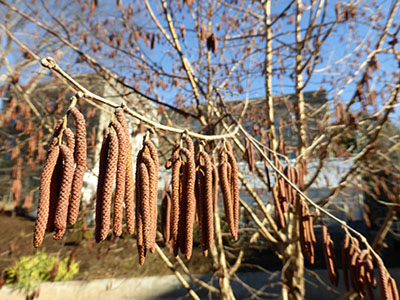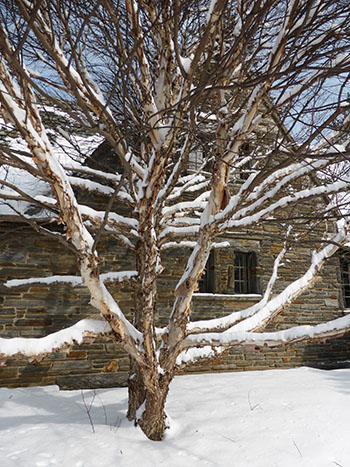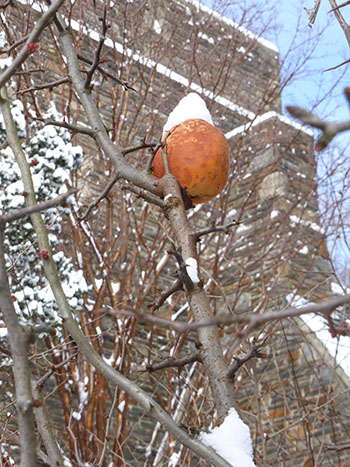Plants of the Week: February 16
 Corylus fargesii needs more praise! Farges hazelnut attributes include peeling creamy salmon-brown bark (think river birch bark), serrated green leaves transitioning to yellow autumn color, and resistance to eastern filbert blight. Several nurseries have high hopes for C. fargesii, placing this Asian native at the top of the list of plants with up and coming landscape potential. Photo credit: J. Coceano
Corylus fargesii needs more praise! Farges hazelnut attributes include peeling creamy salmon-brown bark (think river birch bark), serrated green leaves transitioning to yellow autumn color, and resistance to eastern filbert blight. Several nurseries have high hopes for C. fargesii, placing this Asian native at the top of the list of plants with up and coming landscape potential. Photo credit: J. Coceano
Garden location: raised circle planting in front of Lang Music building
 Betula nigra ‘Little King’ also marketed and sold under the name Fox Valley TM is but one of several river birch cultivars. Touted for its dense, compact growth habit, ‘Little King’ unlike other river birch tends to grow wider than tall. Beautiful exfoliating bark and glossy leaves make this birch an ideal choice for areas with perpetual wetness. Photo credit: J. Coceano
Betula nigra ‘Little King’ also marketed and sold under the name Fox Valley TM is but one of several river birch cultivars. Touted for its dense, compact growth habit, ‘Little King’ unlike other river birch tends to grow wider than tall. Beautiful exfoliating bark and glossy leaves make this birch an ideal choice for areas with perpetual wetness. Photo credit: J. Coceano
Garden location: specimen near Bond Hall
Chaenomeles, or flowering quince, is beloved for its early spring blooms in shades of scarlet, pink, and peach. Upon completion of bloom, one is left with a shrub whose habit is “rather oafish and clumsy…lacking grace and dignity…” This observation, written by Michael Dirr in Dirr’s Encyclopedia of Trees and Shrubs, is one shared by many gardeners. Aside from the habit, one must also contend with the thorns. An aspect not often mentioned is the edible fruit. Varying in size, the spotted acidic fruit is often harvested in late summer and early fall, and cooked, usually boiled, to be used in jams and jellies—often alongside other fruits, such as apples and pears. Photo credit: J. Coceano
Garden location: Mass planting between Chester Road (Route 320) and Bond Hall





No Comments